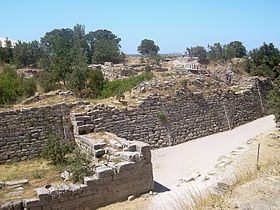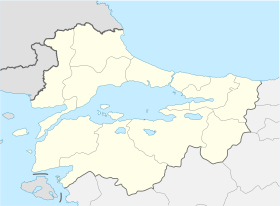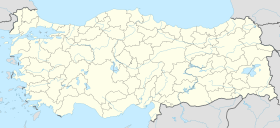Troy
 Walls of Troy VI. | |
 Shown within Marmara | |
| Location | Hisarlik, Çanakkale Province, Turkey |
|---|---|
| Region | Troad |
| Coordinates | 39°57′27″N 26°14′20″E / 39.95750°N 26.23889°ECoordinates: 39°57′27″N 26°14′20″E / 39.95750°N 26.23889°E |
| Type | Ancient city |
| Part of | Historical National Park of Troia |
Troy or Ilion was an ancient city, known as the setting for the Greek myth of the Trojan War. It was located at Hisarlik in present-day Turkey, 30 kilometres (19 mi) south-west of Çanakkale.
In Ancient Greek literature, Troy is portrayed as a powerful kingdom of the Heroic Age, a mythic era when monsters roamed the earth and gods interacted directly with humans. The city was said to have ruled the Troad until the Trojan War led to its complete destruction at the hands of the Greeks. The story of its destruction was one of the cornerstones of Greek mythology and literature, featuring prominently in the Iliad and the Odyssey, as well as numerous other poems and plays. Its legacy played a large role in Greek society, with many prominent families claiming descent from those who had fought there. In the classical era, the site where legendary Troy was believed to have stood became a tourist destination.
Until the late 19th century, modern scholars regarded the Trojan War as entirely fictional. However, starting in 1871, Heinrich Schliemann and Frank Calvert excavated the site of the classical era tourist trap, under whose ruins they found the remains of earlier settlements. Several of these layers resemble literary depictions of Troy, leading some scholars to conclude that there is a kernel of truth to the legends. Schliemann's legacy remains controversial due to his excavation methods, which included dynamiting layers he considered insignificant. Subsequent excavations by others have added to our understanding of the site, though the exact relationship between myth and reality remains unclear.
The archaeological site of Troy consists of nine major layers, the earliest dating from the Early Bronze Age, the latest from the Byzantine era. The mythic city is typically identified with one of the Late Bronze Age layers, such as Troy VI, Troy VIIa, or Troy VIIb. The archaeological site is open to the public as a tourist destination, and was added to the UNESCO World Heritage list in 1998.
Name[]
In Classical Greek, the city was referred to as both Troía (Τροία) and Ī́lion ( Ἴλιον) or Ī́lios ( Ἴλιος). Metrical evidence from the Iliad and the Odyssey suggests that the latter was originally pronounced Wilios. These names may date back to the Bronze Age, as suggested by Hittite records which reference a city in northwest Anatolia called


